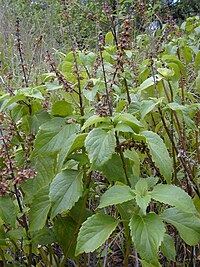
Photo from wikipedia
This study evaluated the toxicity and repellent activities of essential oils (EOs) against Sitophilus granarius (Linnaeus, 1758), both in vitro and in vivo conditions. The EOs obtained from Thymus pallescens Noë. (Lamiaceae) and Cymbopogon citratus… Click to show full abstract
This study evaluated the toxicity and repellent activities of essential oils (EOs) against Sitophilus granarius (Linnaeus, 1758), both in vitro and in vivo conditions. The EOs obtained from Thymus pallescens Noë. (Lamiaceae) and Cymbopogon citratus Stapf. (Poaceae) were analyzed by GC-MS, and revealed that carvacrol (56.64%) and geraniol (20.8%) as the respective major components. T. pallescens EO was found to be a more effective toxicant, with LC50 and LC90 values of 9.3 and 34.6 µL/mL, respectively, in the contact test vs 8.2 and 25.3 µL/mL in the fumigation test. T. pallescens EO showed also a stronger repellent effect with values ranging from 83.4% to 100%. In the in vivo test, the survival probability decreased from 99.9 to 2.48% among insects exposed to T. pallescens EO. These data demonstrated that EOs could be considered effective alternatives to chemical insecticides, providing pest control for stored products in an ecologically sustainable manner.
Journal Title: Plant Protection Science
Year Published: 2021
Link to full text (if available)
Share on Social Media: Sign Up to like & get
recommendations!